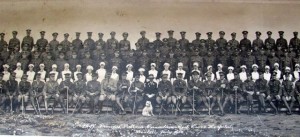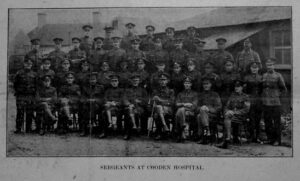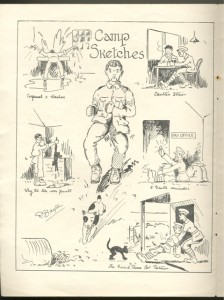 In January 1918 the Cooden Training Camp was taken over and transformed into the Princess Patricia Canadian Red Cross Hospital, relocated from Uxbridge and Ramsgate.
In January 1918 the Cooden Training Camp was taken over and transformed into the Princess Patricia Canadian Red Cross Hospital, relocated from Uxbridge and Ramsgate.
When it closed in August 1919 it was reported to have treated over 20,000 patients. It was designated as a Convalescent Hospital although records indicate that acute wounds and medical conditions were also treated. As with all Bexhill’s hospitals, returning soldiers to combat fitness was a priority but the military nature of Princess Patricia’s and its scale meant that this goal was pursued much more systematically.
The first 131 patients were admitted on 27th March 1918 and the War Diary of the Hospital for that month, published on line by the Canadian Library and Archive, indicates that the Physical Training Department was still not complete and this was an urgent concern so that “these patients will be able to go under their special treatment as soon as possible”. In April the report of the Remedial Gymnastic Department was that in wet weather “it was not possible to do any remedial work as no building was available. Only the crudest kind of machine work was possible”. On May 1st a temporary Remedial Hut was set up and on 11th May a swimming pool was also opened. It was 100 ft long and 40ft wide and 6ft deep and was open to staff and patients.
The Diary for March also contains a long report of the setting up of a Y.M.C.A Hut by Captain M.C. Cross. The emphasis was on sports, but also entertainment and diversionary games such as billiards. Education and reading were also a priority. By June there was a request for more library space and a plan to set up an educational programme using army personnel with teaching experience and becoming part of the Y.M.C.A. Khaki University Scheme.
 The Y.M.C.A. reports make it clear that Princess Patricia’s received support from the local community of Bexhill in much the same way as the other Red Cross Hospitals, although it was not in need of financial or food donations. The ladies of Bexhill invited the patients into their homes and ran whist drives, etc. Local singers also attended religious services in the Hut to lead the singing and to entertain.
The Y.M.C.A. reports make it clear that Princess Patricia’s received support from the local community of Bexhill in much the same way as the other Red Cross Hospitals, although it was not in need of financial or food donations. The ladies of Bexhill invited the patients into their homes and ran whist drives, etc. Local singers also attended religious services in the Hut to lead the singing and to entertain.
However, there is a puzzling lack of notice in the local papers concerning the change of use of Cooden Camp until it was closed down. At that time the Bexhill Observer reported that it “claimed to be the only Canadian Camp in England where there has been no trouble”. Perhaps, also, the presence of the Canadian Training School in the town meant that the arrival of the Canadian Hospital had little impact. The report also included photographs of Officers and Sergeants at the camp in August 1919.
There was a letter from John M. Cronin, R.C. Officiating Chaplin, Canadian Troops, Bexhill Area, printed in the Bexhill Observer 13th April 1918 complaining of rumours that Princess Patricia’s was a hospital for the treatment of Venereal Disease. “I am assured”, he says, “that no venereal cases have been, or will be accepted in this hospital at any time.” On 23rd May, 1918, a lecture on Venereal Disease was given by Captain Kennedy, Canadian Army Medical Corps, (C.A.M.C.), to all C.A.M.C. staff and the War Diary notes “Since then there has been a noticeable increase in the number of men taking advantage of the “Early Treatment”. Thirty-nine men attended the Early Treatment Clinic in May compared to fifteen in April. There was only one confirmed case, a man who had not attended the clinic. As the emphasis in the Diaries is on preventive treatment of staff not patients it is possible that the letter is factually correct at the time of writing.
 The Cooden Beach Red Cross Hospital continued to be run by Voluntary Aid Detachment (VAD) Sussex 38, while the Camp operated as Princess Patricia Canadian Red Cross Hospital. The degree of cooperation between the two Red Cross hospitals is unclear, although reports of the Hospital Sports Day of 1918 suggest mutual awareness and informal contacts, and the Bexhill ladies mentioned in the War Diaries might well have been those who had supported Cooden Beach Hospital since 1914.
The Cooden Beach Red Cross Hospital continued to be run by Voluntary Aid Detachment (VAD) Sussex 38, while the Camp operated as Princess Patricia Canadian Red Cross Hospital. The degree of cooperation between the two Red Cross hospitals is unclear, although reports of the Hospital Sports Day of 1918 suggest mutual awareness and informal contacts, and the Bexhill ladies mentioned in the War Diaries might well have been those who had supported Cooden Beach Hospital since 1914.
Nursing in Princess Patricia was provided by VADs as well as Canadian military nurses. Some VADs came from Tunbridge and from Hertfordshire. Bessie, Martha and Francis Nottage from Sawbridge, Herts, came to Cooden for training in 1918 before going on to serve in a VAD Hospital in Rouen. Phyllis Seymour Lowe was also a nurse at the camp.
The camp also had its own newspaper produced by Staff-Sergeant Firth called The Princess Pat’s Post.


